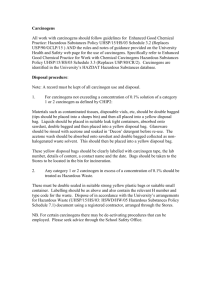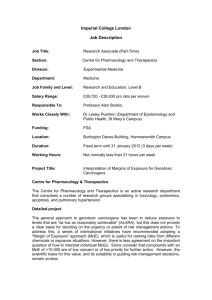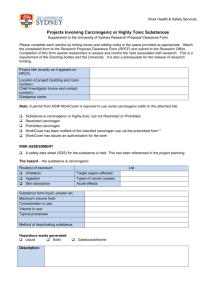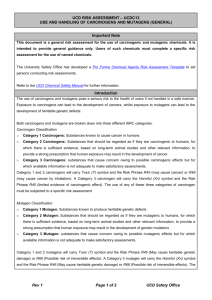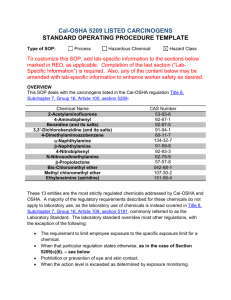CHEMICAL CARCINOGENS
advertisement
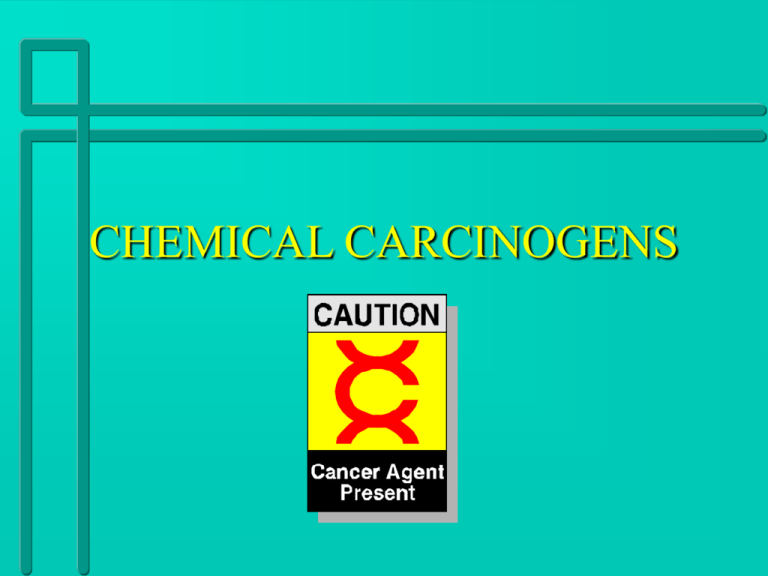
CHEMICAL CARCINOGENS What is a carcinogen? Any substance that is capable of causing cancer. Cancer is the abnormal or uncontrolled growth of new cells in any part of the body, characterized by cells that tend to invade surrounding tissue and metastasize to new body sites. Carcinogens are chronic toxins. They cause damage after repeated or long-duration exposure. They may have not immediate apparent harmful effects, with cancer developing only after a long latency period. What are reproductive toxins? Mutagens cause damage to chromosomes by introducing changes to DNA. Mutagens have adverse effects on fertility and general reproductive performance. Mutagens are chronic toxins Teratogens act during pregnancy to cause adverse effects on the embryo or fetus including malformations, retarded growth and postnatal deficiencies. Reproductive toxins can affect both men and women. What materials are carcinogens? Asbestos Certain chemicals Coal tars and coke oven emissions Hardwood sawdust (certain species) Ionizing radiation Natural products (progesterone, safrole) Tobacco smoke Ultraviolet radiation What is a chemical carcinogen? Any discrete chemical compound which has been shown to cause cancer in human or animal studies. Hundreds of individual compounds have been shown to induce cancers. Many thousands of additional compounds are “suspect” carcinogens. Many are commonly used in laboratory operations, shops and art studios. How is chemical carcinogenicity determined? Epidemiological studies determine the relationship between a cancer suspect chemical and a human population over a long period of time. Animal studies directly induce cancer in test animals using a large sample of animals, usually of two or more species with varying dose and time parameters. Experiments with animals are based on the premise that chemicals that produce cancer in animals will have similar effects on human cells. Most known human carcinogens produce cancer in experimental animals. What is an OSHA “select” carcinogen? Any substance that is regulated by OSHA as a carcinogen. It is listed under the category “know to be carcinogens” in the Annual Report on Carcinogens published by the National Toxicology Program (NTP). It is listed under Group 1 (“carcinogenic to humans”) by the International Agency for Research on Cancer (IARC). It is listed in either Group 2A (“limited evidence of carcinogenicity” from human studies) or 2B (“sufficient evidence of carcinogenicity” from animal studies) by IARC or under the category “reasonably anticipated to be carcinogens by NTP. (A specified dose range is given.) Which classes of chemicals tend to be carcinogens? Epoxides: Ethylene oxide Propylene oxide Hydrazines: Hydrazine (and salts) 1,2-Dimethylhydrazine N-Nitroso compounds: N-Nitrosodimethylamine Organohalogen comp.: Vinyl chloride Carbon tetrachloride Chloroform Hexachlorobenzene Trichloroethylene Aromatic Amines: Benzidine Aniline o-Anisidine o-Toluidine Aromatic hydrocarbons: Benzene Benz[a]anthracene Benzo[a]pyrene Classes of carcinogens (cont.) Misc. organic compounds: Formaldehyde Acetaldehyde 1,4-Dioxane Ethyl carbamate 2-Nitropropane Styrene Thiourea Thioacetamide Misc. inorganic comp.: Arsenic and compounds Chromium and comp. Thorium dioxide Beryllium and compounds Cadmium and compounds Lead and compounds Nickel and compounds Selenium sulfide How do carcinogens enter the body? Skin absorption. Many solvents and other chemicals go directly through the skin. Ingestion. Swallowing of a carcinogen. Inhalation. Breathing gases, fumes and vapors is the most common form of exposure. What organs to carcinogens attack? Lungs Liver Kidney Reproductive system Skin Many other organs and tissues What factors influence the development of cancer? Dose--amount and length of exposure. The lower the dose the least likely you are to develop cancer or related diseases. Environmental or “lifestyle” factors. Cigarette smoking (co-carcinogen) Alcohol consumption (co-carcinogen) Diet--high fat consumption, natural antioxidants Geographic location--industrial areas, UV light Therapeutic drugs--some are known carcinogens Inherited conditions How do I reduce my exposure to carcinogens? Engineering controls--exhaust ventilation and equipment Personal protective equipment Personal hygiene Labeling and storage of containers Housekeeping and maintenance Regulated areas Decontamination and emergency procedures Monitoring Administrative controls Engineering controls--exhaust ventilation and equipment General room ventilation--10 or more changes of air per hour. Designed to reduce exposures below the permissible exposure limit (PEL). Many carcinogens have a very low exposure limit. Use an “ALARA” policy. Fume hoods--full open face velocity of 8o to 100 l.f.p.m.. combined with a dry ice capture test. Local ventilation--exhaust (sometimes supply) at the point of use of a chemical. “Elephant trunk” or slot hood. Carcinogen glove box or environmental chamber. Biosafety cabinet--used for anticancer drugs, viruses. No benchtop work in a laboratory setting. Personal protective equipment Respiratory protection--dust masks, respirators. Respirators are primarily for use in non-lab areas, except for emergency response (spill cleanup)--shops, floor stripping, construction operations (painting). Eye protection--safety glasses, splash goggles, face shields. Hand protection--gloves, protective sleeves. Protective clothing--lab coats, aprons, Tyvek garments. OSHA standards for personal protective equipment supersede other OSHA standards. Personal hygiene No smoking, eating, drinking or application of cosmetics is permitted in areas where carcinogens are in use (or in any lab area!). No mouth pipetting! Wash hands and any exposed skin if potentially contaminated--face, neck, forearms, etc. No shorts or open toed shoes. Remove lab coat or other potentially contaminated protective clothing before leaving the work area. Lab coats need to be cleaned regularly; special washing instructions may be needed. Contaminated disposable clothing should be treated as hazardous waste Labeling of containers All containers of chemical carcinogens need to have a warning label affixed to them. A Right-to-Know (RTK) style label must be on any container of material that is repackaged or made into a solution more than 0.1%. All areas where carcinogens may be used, present or stored should have prominently displayed warning signs or labels both in the areas and access to them.. Some warning signs and labels are described by specific standards. “DANGER--Contains ___________ CANCER HAZARD” Storage of containers Carcinogens must be stored separately from other materials. Separated by shelving system or secondary containment. Secondary containment means placing chemical containers in an outer container to prevent the release of a chemical in the event that its container breaks or ruptures. Desiccators, plastic boxes, bottle-in-can are acceptable secondary containment. Storage areas must be labeled “Danger--Carcinogens Stored Here.” Housekeeping and maintenance Keep all work surfaces and equipment clean. Dry sweeping or compressed air cleaning of floors or work surfaces is prohibited. Dry cleaning of surfaces and equipment must be done by vacuum systems with high-efficiency filters. All contaminated floor sweepings, debris (paper towels, Kimwipes, plasticware), discarded filters from respirators or vacuums must be bagged, properly labeled and sent out for incineration. Regulated areas Establish regulated or designated areas for the use of carcinogens. (Required in Lab Standard.) Locations where entry and exit or use of an area is restricted to the use of carcinogens. Only authorized persons trained in the use of the carcinogens present may use these areas when such materials are in use. Regulated areas are usually under negative pressure (fume hood) to contain carcinogens in the hood or room. Decontamination and emergency procedures Safety shower and eyewash station nearby. Special solutions or solvents on hand if required for decontamination of skin, eyes. Spill mixtures and cleanup materials for spills on hand. All used spill cleanup materials must be treated as hazardous waste. Respirator may be needed for spill cleanup. Any “incidental” spill may be cleaned up by the lab staff; larger spills may require a emergency response (5-1111). Fire extinguisher at hand as required. Training needed. Written emergency response plan. Training required. Monitoring If there is reason to believe that a PEL may be exceeded then personal exposure monitoring is required. This may be done by EH&S staff. Personnel monitoring with sample pumps or badges. Area monitoring may be required in some cases. Medical monitoring may be required if it is anticipated that PELs may be exceeded. Examination by a physician, blood tests, etc. Required whenever there is a spill or other emergency. Results of monitoring must be supplied to the employee. Records of exposures,. monitoring, and medical exams must be kept for 30 years. Administrative controls Material Safety Data Sheets and other information. Training--all employees using carcinogens must be trained in the recognition of the physical and health hazards associated with the carcinogens they are working with, methods to detect the presence or release of a carcinogen and ways to protect themselves from exposure to the carcinogens with which they are working. Specialized training may be required for specific carcinogens. Written exposure control plans, if required. Limitations on the duration of exposure. How do I dispose of waste carcinogens? With very few exceptions (dilute formaldehyde solutions) carcinogens may never be discharged to the sanitary sewer. Carcinogens may never be disposed of in the ordinary trash. Waste bottles must be properly labeled, tightly capped at all times (except when adding or removing waste) and they must have secondary containment. See section 7.9-11 of the CHP for waste bottle labeling instructions. Check “Poison” on the waste label. Dry wastes must be incinerated or shipped out as regulated medical waste (“chemotheraputic agents”). How do I reduce my inventory and level of waste generation? Plan the use of carcinogens carefully. Do not make more stock solutions than are required. Substitute less hazardous materials for carcinogens whenever possible; toluene instead of benzene. Purchase carcinogens in the smallest possible quantities. Do not allow inventories to accumulate. Place no longer needed materials in a recycling program or dispose of as waste. Detoxify carcinogens as part of your research protocols. Formaldehyde is easily detoxified by NH4OH, for example. The Standard Operating Procedure (SOP) Standard Operating Procedures (SOP) “relevant to safety and health considerations” need to be developed when carcinogens are in use. An SOP may be developed for an individual carcinogen, a process or a class of chemicals. An SOP must contain the following: The name and location of the chemical, purchasing and usage authorization, training requirements, location of use, PPE required, methods of waste disposal, decontamination, first aid measures, spill control, emergency phone numbers and any other relevant information. Employees must be trained in the content of the SOP. The End “There are old researchers and there are bold researchers, but there are no old, bold researchers!” Anon.
